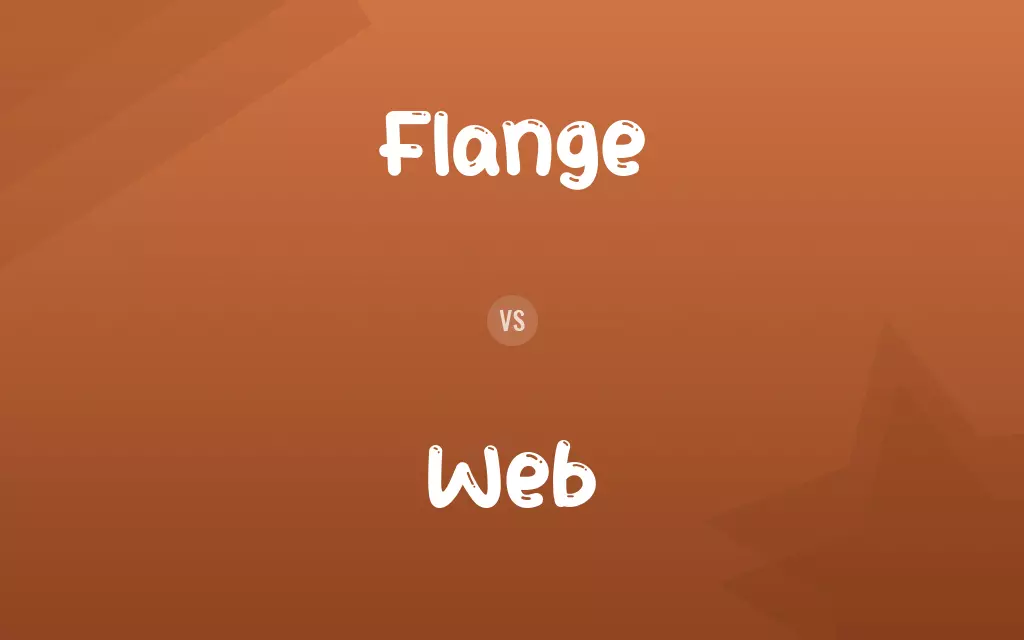Flange vs. Web: Difference and Comparison
Edited by Muazma Batool — By Muneeza Rehman — Updated on February 21, 2024
A flange refers to a projecting flat rim or collar used for strength or attachment, whereas a web is the central part of a beam that provides resistance to shear forces.

Difference Between Flange and Web
Flanges are essential components in various applications, providing reinforcement, connecting pipes, or attaching to other objects. They project out from the main body of an object, offering a broader surface for securing connections. In contrast, the web of a beam or structural element is the vertical or central part that connects the top and bottom flanges, playing a crucial role in resisting shear stress and distributing forces along the length of the beam.
Muneeza Rehman
Feb 21, 2024
The design of a flange focuses on the distribution of stress over a wide area and facilitating connections between different components, such as in piping systems, where flanges are used to bolt two sections together. On the other hand, the web's design is optimized for structural efficiency, primarily to handle shear forces and provide stability to the entire structural element, like in I-beams used in construction.
Muneeza Rehman
Feb 21, 2024
In terms of construction and engineering, flanges can be found on beams, but their primary purpose is different; they are the outer edges that support loads, work with the web to resist bending moments. Whereas the web, being the central part, significantly contributes to the beam's strength against vertical forces, emphasizing the collaboration between flange and web in structural beams.
Muneeza Rehman
Feb 21, 2024
Flanges are not limited to beams and can be integral parts of equipment like flange bearings, flanged wheels, or pipe flanges, highlighting their versatility in providing points of attachment or connection. In contrast, webs are specific to structural members, defining their capability to bear loads and resist shear.
Leo
Feb 21, 2024
The material selection for flanges and webs can vary based on their application. Flanges often require materials that can withstand high stress and corrosion, especially in piping systems. Webs need materials that have a good balance of strength and weight to support structural integrity without adding unnecessary bulk.
Olivia
Feb 21, 2024
Flange vs. Web Comparison Chart
Definition
A projecting flat rim or collar used for strength or attachment.
The central part of a beam that resists shear forces.
Muneeza Rehman
Feb 21, 2024
Primary Function
To provide reinforcement, facilitate connections, or attach objects.
To connect the top and bottom parts of a beam and resist shear stress.
Muneeza Rehman
Feb 21, 2024
Applications
Piping systems, machinery, structural beams.
Structural beams, girders, and other load-bearing elements.
Muneeza Rehman
Feb 21, 2024
Material Considerations
Must withstand high stress and possibly corrosion.
Requires strength with an optimal balance of weight.
Elijah
Feb 21, 2024
Design Focus
Stress distribution and connection facilitation.
Shear resistance and structural efficiency.
Muneeza Rehman
Feb 21, 2024
Flange vs. Web Definitions
◉Flange
Integral to beam construction for load support.
The flange of the I-beam was crucial for bearing the weight of the floor above.
Olivia
Feb 21, 2024
◉Web
Connects the top and bottom of a structural element.
The web ensures the integrity of the beam by connecting its flanges.
Leo
Feb 21, 2024
◉Flange
Common in equipment for attachment points.
The motor had a flange for easy mounting onto the machine frame.
William
Feb 21, 2024
◉Web
The central part of a beam that provides shear resistance.
The web of the steel beam prevented it from shearing under heavy loads.
Muneeza Rehman
Feb 21, 2024
◉Flange
A projecting rim used to strengthen or connect components.
The pipe flange enabled a secure connection between the two pipes.
Muneeza Rehman
Feb 21, 2024
◉Web
Essential for structural efficiency.
A well-designed web contributes significantly to the beam's overall strength.
Leo
Feb 21, 2024
◉Flange
Designed for stress distribution.
The flange was engineered to distribute the load evenly across its surface.
Jonathan
Feb 21, 2024
◉Web
Specific to load-bearing structures.
The web in the bridge's girders was thickened to enhance durability.
Elijah
Feb 21, 2024
◉Flange
Versatile in application.
Flanges are used in various industries, from construction to machinery.
Leo
Feb 21, 2024
◉Web
Balances strength and weight.
The material for the web was chosen for its strength-to-weight ratio, optimizing the structure.
Jonathan
Feb 21, 2024
◉Flange
A protruding rim, edge, rib, or collar, as on a wheel or a pipe shaft, used to strengthen an object, hold it in place, or attach it to another object.
Muneeza Rehman
May 03, 2023
◉Flange
A wide edge on a pillow, placemat, or other fabric object, especially a piece of fabric or ribbon extending from the outer seam.
Muneeza Rehman
May 03, 2023
Flange vs. Web Frequently Asked Questions
What is a web in construction?
In construction, a web is the central part of a beam or structural element that resists shear forces, connecting the top and bottom flanges.
Muneeza Rehman
Feb 21, 2024
Can flanges and webs be found together?
Yes, in structural beams, flanges and webs work together, with flanges supporting loads and webs resisting shear forces.
Muneeza Rehman
Feb 21, 2024
What is a flange?
A flange is a projecting flat rim or collar, often used for strengthening, connecting, or attaching parts in various applications.
Muneeza Rehman
Feb 21, 2024
Can the design of a flange affect the overall performance of a structure?
Yes, the design of a flange affects how stress is distributed and how well components are connected, impacting the structure's performance.
Jonathan
Feb 21, 2024
How does the web contribute to a beam's strength?
The web provides shear resistance, essential for the beam's stability and strength, by connecting the flanges and distributing vertical forces.
Muneeza Rehman
Feb 21, 2024
What materials are used for flanges?
Flanges are made from materials that can handle high stress and corrosion, such as steel, depending on their specific application.
William
Feb 21, 2024
Why is the web's design important in structural elements?
The web's design is critical for ensuring structural efficiency and integrity, as it must resist shear forces without adding unnecessary weight.
Nolan
Feb 21, 2024
Are flanges only used in beams?
No, flanges have a wide range of applications beyond beams, including piping systems and machinery for connecting or attaching components.
Muneeza Rehman
Feb 21, 2024
Are webs only used in horizontal beams?
Webs are primarily associated with beams, which can be horizontal or vertical in structures, playing a key role in their load-bearing capacity.
Levi
Feb 21, 2024
How do engineers decide on the thickness of a web?
The thickness of a web is determined based on the expected shear forces and the need for structural efficiency, balancing strength and weight.
Leo
Feb 21, 2024
Content Creators
Written by
Muneeza RehmanAt Comparisons.wiki, Muneeza skillfully navigates the vast sea of information, ensuring clarity and accuracy as the lead content editor. With a keen eye for detail, she curates every comparison to enlighten and engage readers.
Edited by
Muazma BatoolAs a content editor, Muazma Batool is not just a grammar guru but a creative mastermind who breathes life into every word. With an eagle eye for detail and a passion for storytelling, she transforms bland text into engaging content that captivates audiences and drives results.

































